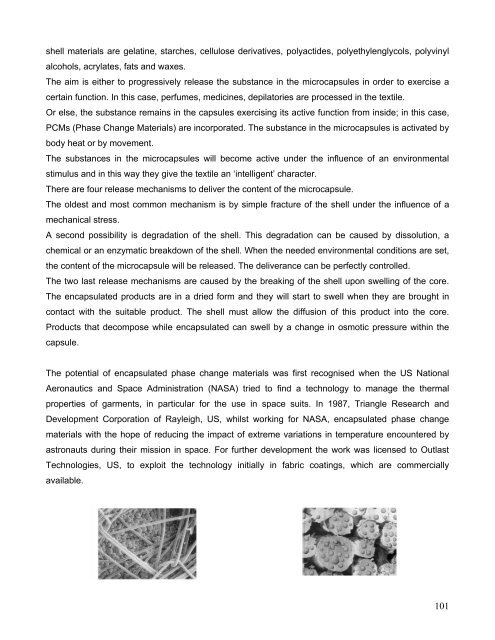Clevertex - Grado Zero Espace Srl
Clevertex - Grado Zero Espace Srl
Clevertex - Grado Zero Espace Srl
Create successful ePaper yourself
Turn your PDF publications into a flip-book with our unique Google optimized e-Paper software.
shell materials are gelatine, starches, cellulose derivatives, polyactides, polyethylenglycols, polyvinyl<br />
alcohols, acrylates, fats and waxes.<br />
The aim is either to progressively release the substance in the microcapsules in order to exercise a<br />
certain function. In this case, perfumes, medicines, depilatories are processed in the textile.<br />
Or else, the substance remains in the capsules exercising its active function from inside; in this case,<br />
PCMs (Phase Change Materials) are incorporated. The substance in the microcapsules is activated by<br />
body heat or by movement.<br />
The substances in the microcapsules will become active under the influence of an environmental<br />
stimulus and in this way they give the textile an ‘intelligent’ character.<br />
There are four release mechanisms to deliver the content of the microcapsule.<br />
The oldest and most common mechanism is by simple fracture of the shell under the influence of a<br />
mechanical stress.<br />
A second possibility is degradation of the shell. This degradation can be caused by dissolution, a<br />
chemical or an enzymatic breakdown of the shell. When the needed environmental conditions are set,<br />
the content of the microcapsule will be released. The deliverance can be perfectly controlled.<br />
The two last release mechanisms are caused by the breaking of the shell upon swelling of the core.<br />
The encapsulated products are in a dried form and they will start to swell when they are brought in<br />
contact with the suitable product. The shell must allow the diffusion of this product into the core.<br />
Products that decompose while encapsulated can swell by a change in osmotic pressure within the<br />
capsule.<br />
The potential of encapsulated phase change materials was first recognised when the US National<br />
Aeronautics and Space Administration (NASA) tried to find a technology to manage the thermal<br />
properties of garments, in particular for the use in space suits. In 1987, Triangle Research and<br />
Development Corporation of Rayleigh, US, whilst working for NASA, encapsulated phase change<br />
materials with the hope of reducing the impact of extreme variations in temperature encountered by<br />
astronauts during their mission in space. For further development the work was licensed to Outlast<br />
Technologies, US, to exploit the technology initially in fabric coatings, which are commercially<br />
available.<br />
101

















